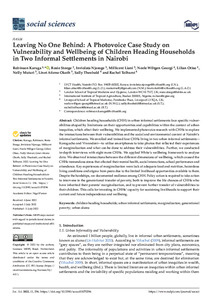| dc.contributor.author | Karuga, R. |
| dc.contributor.author | Steege, R. |
| dc.contributor.author | Njoroge, I. |
| dc.contributor.author | Liani, M. |
| dc.contributor.author | Georgi, N.W. |
| dc.contributor.author | Otiso, L. |
| dc.contributor.author | Muturi, N. |
| dc.contributor.author | Okoth, L.A. |
| dc.contributor.author | Theobald, S. |
| dc.contributor.author | Tolhurst, R. |
| dc.date.accessioned | 2022-12-12T07:52:58Z |
| dc.date.available | 2022-12-12T07:52:58Z |
| dc.date.issued | 2022 |
| dc.identifier.citation | Karuga, R., Steege, R., Njoroge, I., Liani, M., Georgi, N.W., Otiso, L., ... & Tolhurst, R. (2022). Leaving no one behind: a photovoice case study on vulnerability and wellbeing of children heading households in two informal settlements in Nairobi. Social Sciences, 11:296, 1-22. |
| dc.identifier.issn | 2076-0760 |
| dc.identifier.uri | https://hdl.handle.net/20.500.12478/7965 |
| dc.description.abstract | Children heading households (CHH) in urban informal settlements face specific vulnerabilities shaped by limitations on their opportunities and capabilities within the context of urban inequities, which affect their wellbeing. We implemented photovoice research with CHHs to explore the intersections between their vulnerabilities and the social and environmental context of Nairobi’s informal settlements. We enrolled and trained four CHHs living in two urban informal settlements—Korogocho and Viwandani—to utilise smartphones to take photos that reflected their experiences of marginalisation and what can be done to address their vulnerabilities. Further, we conducted in-depth interviews with eight more CHHs. We applied White’s wellbeing framework to analyse data. We observed intersections between the different dimensions of wellbeing, which caused the CHHs tremendous stress that affected their mental health, social interactions, school performance and attendance. Key experiences of marginalisation were lack of adequate food and nutrition, hazardous living conditions and stigma from peers due to the limited livelihood opportunities available to them. Despite the hardships, we documented resilience among CHH. Policy action is required to take action to intervene in the generational transfer of poverty, both to improve the life chances of CHHs who have inherited their parents’ marginalisation, and to prevent further transfer of vulnerabilities to their children. This calls for investing in CHHs’ capacity for sustaining livelihoods to support their current and future independence and wellbeing. |
| dc.description.sponsorship | UKRI Collective Fund |
| dc.format.extent | 1-22 |
| dc.language.iso | en |
| dc.subject | Households |
| dc.subject | Poverty |
| dc.subject | Kenya |
| dc.title | Leaving no one behind: a photovoice case study on vulnerability and wellbeing of children heading households in two informal settlements in Nairobi |
| dc.type | Journal Article |
| cg.contributor.affiliation | LVCT Health, Kenya |
| cg.contributor.affiliation | London School of Tropical Medicine and Hygiene |
| cg.contributor.affiliation | International Institute of Tropical Agriculture |
| cg.contributor.affiliation | Liverpool School of Tropical Medicine |
| cg.coverage.region | Africa |
| cg.coverage.region | East Africa |
| cg.coverage.country | Kenya |
| cg.coverage.hub | Eastern Africa Hub |
| cg.identifier.bibtexciteid | KARUGA:2022 |
| cg.isijournal | ISI Journal |
| cg.authorship.types | CGIAR and developing country institute |
| cg.iitasubject | Livelihoods |
| cg.iitasubject | Smallholder Farmers |
| cg.iitasubject | Socioeconomy |
| cg.journal | Social Sciences |
| cg.notes | Open Access Article; Published online: 11 Jul 2022 |
| cg.accessibilitystatus | Open Access |
| cg.reviewstatus | Peer Review |
| cg.usagerightslicense | Creative Commons Attribution 4.0 (CC BY 0.0) |
| cg.targetaudience | Scientists |
| cg.identifier.doi | https://dx.doi.org/10.3390/socsci11070296 |
| cg.futureupdate.required | No |
| cg.identifier.volume | 11 |

